SUTTON SCARSDALE HALL, DERBYSHIRE.
It was only after leaving the forces in 1977 that Sutton Scarsdale Hall gained my interest and I decided to find out what I could about the previous owners of the Sutton Scarsdale Hall and previous Manors that occupied the site. Delving further I discovered that the current Hall is either the fourth or fifth property to have been built on the site. All the information I have collected is from the Internet and Chesterfield Public Library to whom I am extremely grateful. There are too many sites and books to acknowledge individually but I have condensed the information I have collated and collected from all sources in order to complete this information. To all sources I give my thanks and hope the information will convey to you all a better insight into this once magnificent property. Graham E. March
THE OWNERSHIP OF SUTTON SCARSDALE HALL
WULFRIC SPOTT – Bequeathed his Manor and lands in Sutton-la-Dal to Burton Abbey.
1010 – BURTON ABBEY – The abbey placed a tenant and protector in the Manor.
1010 – STEINULF the SAXON – placed as tenant and protector of Sutton Manor. 1086 – William 1 – removed the Manor and lands from the care of the monks and removed Steinulf the Saxon and gave the manor and lands to one of his knights.
1086 – ROGER de POITOU – received the manor and lands for services rendered. He joined his brother’s rebellion against Henry 1 of England, which failed. This resulted in him losing the Manor and lands. He left England and went to France.
1102 – 1225 – During these years there is a gap in the knowledge of ownership.
1225 – PETER de HARESTON – given the Lordship of Sutton-in-the-Dale by King Henry III. He tenanted it to William de Sutton. On the death of Peter de Hareston, the ownership passed to his heiress daughter, Lucia.
1265 – RICHARD de GREY of SANDIACRE – inherited Sutton–in-the-Dale on his marriage to Lucia. On his death ownership passed to his Grandson, (due to his son predeceasing him).
1298 – RICHARD de GREY – died aged thirty three years. Passed to his four-year-old son William Grey.
1311 – WILLIAM GREY – on his death the manor fell to his daughter and heiress Alice, who married Edward Hillary, (who took the name of Grey).
1338 – EDWARD GREY – on his death, the Manor and lands passed to his Grandaughter, Alice, who married John Leke.
1432 – JOHN LEKE – resided in Langford, so the manor and lands continued in tenancy. He had two sons, William and Thomas. Being the eldest son William succeeded his father.
1449 – WILLIAM LEKE – Continued to live at Langford. He predeceased his mother Alice Grey. This left his son John Leke, heir to Sutton Manor and all estates owned by his father.
1458 – JOHN LEKE (The Elder) – only eight years old when he inherited. He married Elizabeth Savage. John and his wife made Sutton Manor their home. Succeeded by his eldest son, John (The Younger).
1505 – SIR JOHN LEKE (The Younger) – married Jane Foljambe. He went to France in the army of King Henry. When Henry joined his army John Leke was Knighted. On his death his eldest son Francis succeeded his father, at the age of thirteen.
1522 – SIR FRANCIS LEKE (The Elder) – Due to his age, his Uncle Godfrey Foljambe became his guardian. On his death, the manor and estates passed to his eldest son.
1581 – SIR FRANCIS LEKE (The Younger) – Due to his great age and health, he stayed at his home in Newark. On his death, in 1626, the manor and estate passed to his son.
1626 – SIR FRANCIS LEKE (Baron Deincourt; 1st Earl Scarsdale) – after the death of his eldest son at the Battle of Landsdowne, Francis became a Royalist and fortified Sutton due to the sieges of Bolsover and Staveley in 1643. The house and its garrison were taken by storm. He died in 1655 and Sutton was passed to his eldest son, who had joined the Parliamentarians after the fall of Sutton.
1655 – NICHOLAS LEKE (Baron Deincourt; 2nd Earl Scarsdale) – due to him joining the Parliamentarians, his father cut him off without a penny and he was forced to rent some of his father’s confiscated properties. An act was passed to settle the estates for a fine of £18000. His friends paid the fine for him. His eldest son died in infancy, therefore, his second son, Robert inherited.
1680 – ROBERT LEKE (Baron Deincourt; 3rd Earl Scarsdale) – a proclamation to apprehend him for High Treason was issued in May 1692, but the Lord Chancellor laid bail on him in the sum of £5000. He died in 1707 and is buried in Westminster Abbey. Having no heirs he was succeeded by his nephew, Nicholas, son of his deceased brother Richard Leke.
1707 – NICHOLAS LEKE (Baron Deincourt; 4th Earl Scarsdale) – due to him supporting the Jacobite Rising, he was accordingly arrested and committed to the Tower at the King’s pleasure. He was discharged in 1716, retired from public life and spent the remainder of his life in improving his Sutton estate and in rebuilding Sutton Scarsdale Hall. Due to his lavish spending he died with debts of £97,116. 15s. 3d and the estates were sold to pay his debts. With his death, the Barony of Deincourt and he Earldom of Scarsdale as well as the Baronetcy, became extinct
1740 – GODFREY BAGNALL CLARKE – he was a British M.P. representing Derbyshire. His personal politics are unknown and he seems never to have spoken in the House of Commons. He died in 1774 and the estate passed to his sister who married Joseph Hart Pryce.
1787 – JOSEPH HART PRYCE (Clarke from 1787) – he had a daughter, Anna Maria Catherine Clarke. She inherited the Hall and estate on her marriage to Walter Butler.
1805 – WALTER BUTLER (1st Marquess & 18th Earl of Ormonde – was an Irish peer and politician. He gained ownership through his marriage to Anna Maria Catherine Clarke. On his death, the Marquisate became extinct but the Earldon of Ormonde passed to his brother James Wandesford Butler. 1820 – 1824 During these years there is a gap in the knowledge of ownership
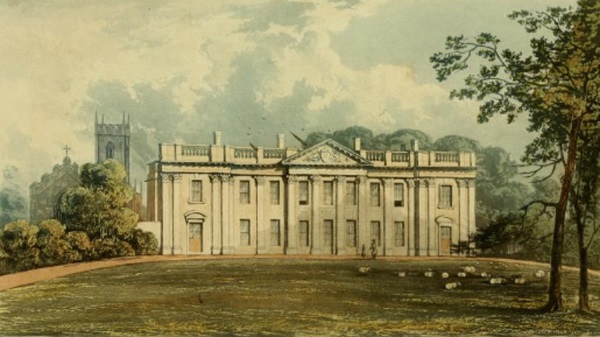
Engraving - 1820 (Public Domain - Wikipedia.org)
1824 – RICHARD ARKWRIGHT JNR
He was the son of Sir Richard Arkwright who invented the Spinning Jenny. He also prospered in the cotton industry. He later channelled his expertise on property, made a large fortune and when he died in 1843 he was said to be the richest commoner in England.
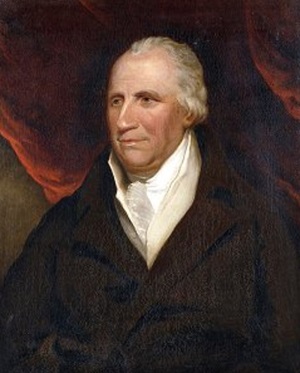
Richard Arkwright Junior - 1800 (Publc domain - Wikipedia.org)
1843 – ROBERT ARKWRIGHT – married the actress Frances Crawford Kemble. On his death in 1859, Sutton Scarsdale Hall was inherited by Godfrey Harry Arkwright his youngest son.
1859 – REVEREND GODFREY HARRY ARKWRIGHT – he married twice and fathered three children with each wife, four boys and two girls. His eldest son was Francis who inherited Sutton Scarsdale Hall on his father’s death in 1866.
1866 – FRANCIS ARKWRIGHT – became a member of parliament and represented Derbyshire in the House of Commons until 1880. He married Evelyn Addington Wells, the daughter of William 3rd Viscount of Sidmouth. In 1882 he emigrated to New Zealnad and having no male heirs, he left Sutton Scarsdale Hall in the care of his cousin, William. When Francis died, William inherited the property.
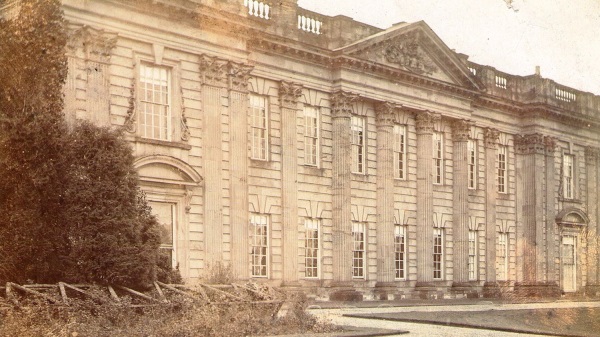
1900 (Public Domain - Wikipedia.org)
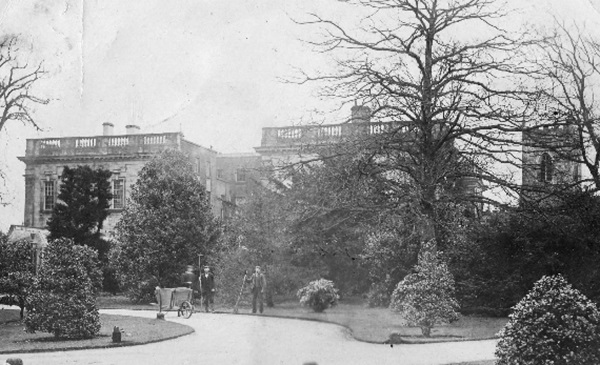
View of the courtyard - 1900 (Public Domain - Wikipedia.org)
1915 – WILLIAM ARKWRIGHT
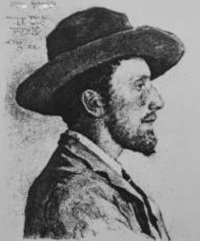 William
Arkwright - 1890 (Public Domain - Wikipedia.org)
William
Arkwright - 1890 (Public Domain - Wikipedia.org)
He was the son of Major William Arkwright, brother of Reverend Godfrey Harry Arkwright. He was very interested in dog breeding and wrote a book ‘The Pointer and His Predecessors’. After many years of neglect, in 1919, William put Sutton Scarsdale Hall up for auction together with the rest of the estate.
1919 – CHESTERFIELD BUSINESSMEN – bought the property and asset-stripped the house; this went as far as removing the roof in 1920. Some parts of the house were shipped to the USA. Three interiors are displayed in the Museum of Art in Philadelphia and a pine panelled room in at the Huntington Library in California. The once great Hall now stood as a desolate and barren ruin and it was decided to demolish this imposing shell of a once grandiose Georgian Mansion with an imposing columned exterior. Just three days before demolition took place in 1946 the Hall and estate was purchased by Sir Osbert Sitwell.
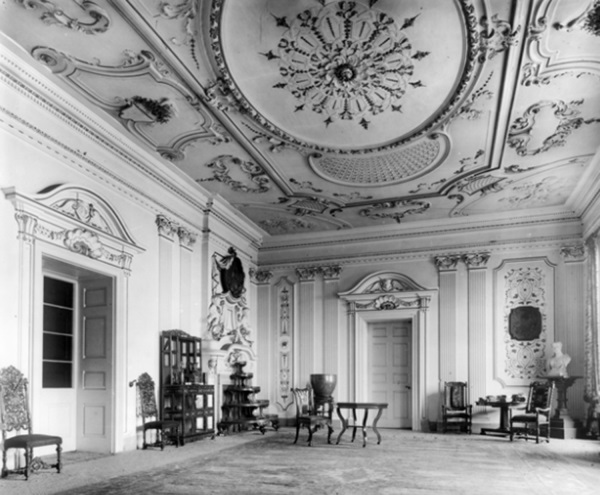
Entrance hall - 1919 (Public Domain - Wikipedia.org)
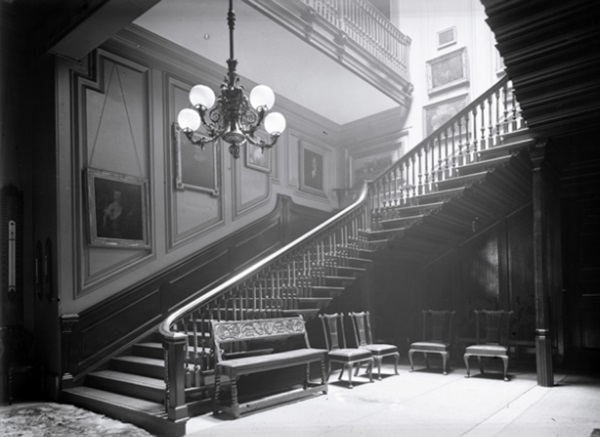
Entrance and hallway - 1919 (Public Domain - Wikipedia.org)
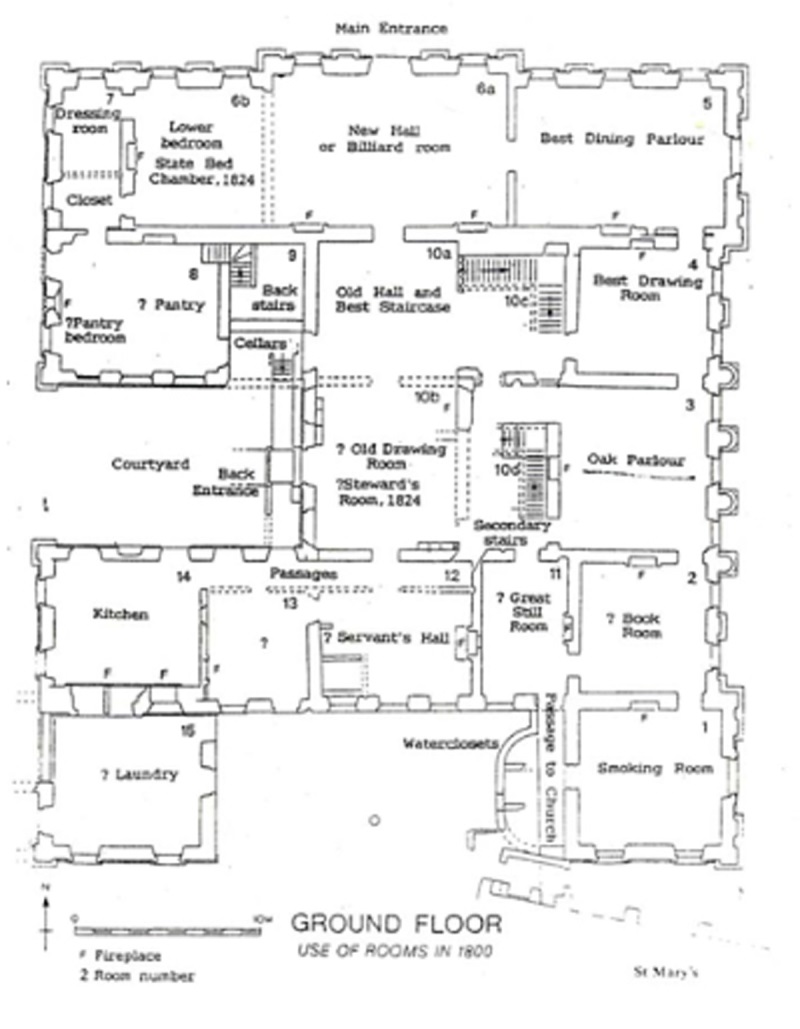
Floor plan - 1920 (Public Domain - Wikipedia.org)
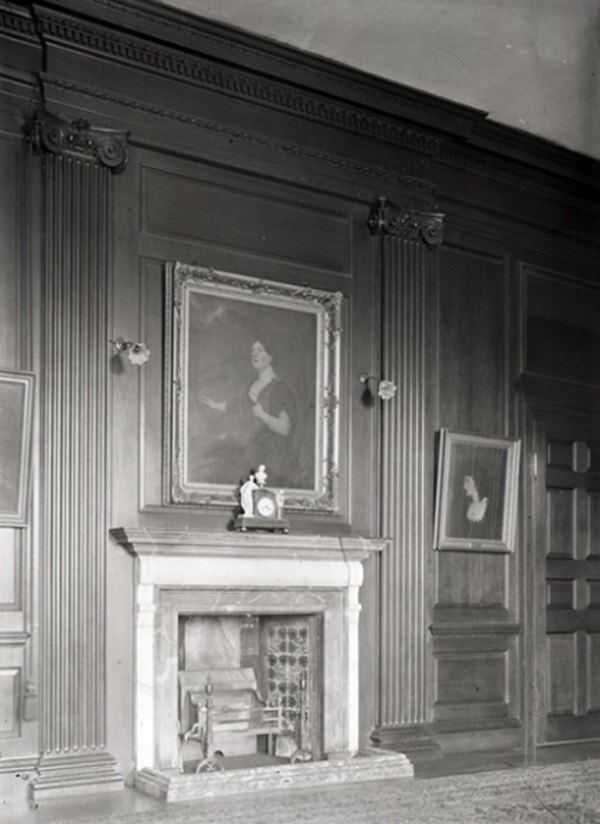
Oak room 1919 showing portrait of Mrs Robert Arkwright (Public Domain - Wikipedia.org)
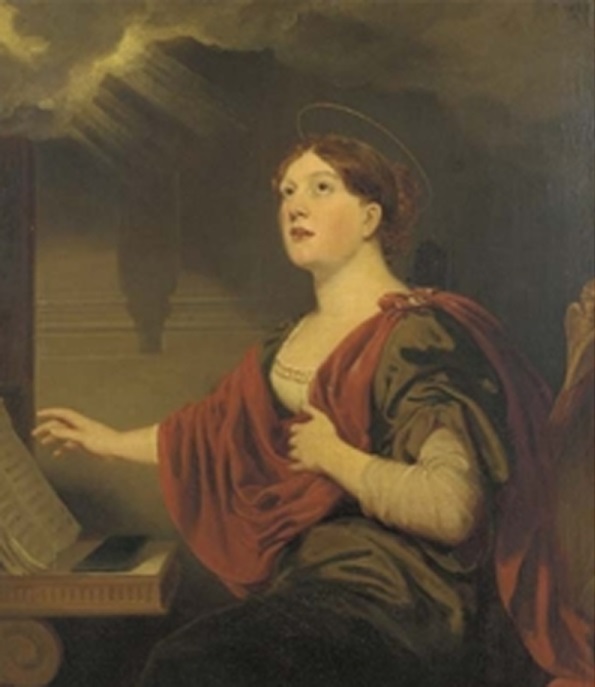
Mrs Robert Arkwright as St Cecilia (Public Domain - Wikipedia.org)
1946 – SIR FRANCIS OSBERT SACHEVERELL SITWELL (5th Baronet) of Renishaw Hall – he purchased the property with the intention of preserving the remaining shell as a ruin. He handed over the Hall to the Department of the Environment to make it safe for viewing. The Hall was then handed over to English Heritage where it is now freely accessible to visitors.
The information I have given here is condensed from all the information which I have collected and compiled for my own interest.
Graham E. March